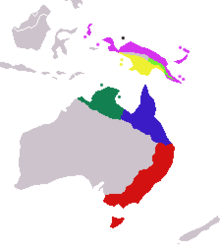Sugar glider
| Sugar glider | |
|---|---|
 |
|
| Scientific classification | |
| Kingdom: | Animalia |
| Phylum: | Chordata |
| Class: | Mammalia |
| Infraclass: | Marsupialia |
| Order: | Diprotodontia |
| Family: | Petauridae |
| Genus: | Petaurus |
| Species: | P. breviceps |
| Binomial name | |
|
Petaurus breviceps Waterhouse, 1839 |
|
| Subspecies | |
|
P.b. ariel, Gould 1842 |
|
 |
|
| Sugar glider natural range by subspecies: P. b. breviceps P. b. tafa |
|
| Synonyms | |
|
P. (Belideus) breviceps, Waterhouse 1839 |
|
P.b. ariel, Gould 1842
P.b. breviceps, Waterhouse 1838
P.b. longicaudatus, Longman 1924
P.b. papuanus, Thomas 1888
P. b. breviceps
P. b. longicaudatus
P. b. ariel
P. b. papuanus
P. b. tafa
P. b. flavidus
P. b. biacensis
P. (Belideus) breviceps, Waterhouse 1839
P. (Belideus) notatus, Peters 1859
P. kohlsi, Troughton 1945
The sugar glider (Petaurus breviceps) is a small, omnivorous, arboreal, and nocturnal gliding possum belonging to the marsupial infraclass. The common name refers to its preference for sugary nectarous foods and ability to glide through the air, much like a flying squirrel. They have very similar appearance and habits to the flying squirrel despite not being closely related, an example of convergent evolution. The scientific name, Petaurus breviceps, translates from Latin as "short-headed rope-dancer", a reference to their canopy acrobatics.
...
Wikipedia

